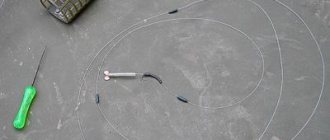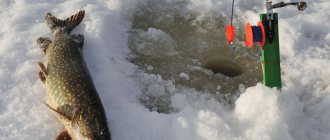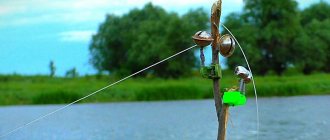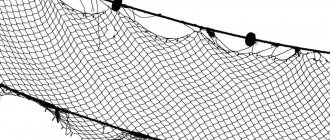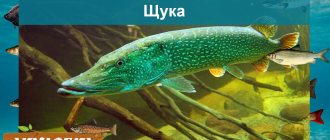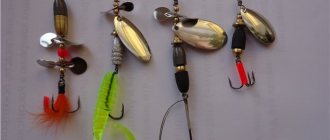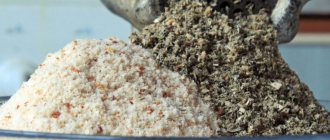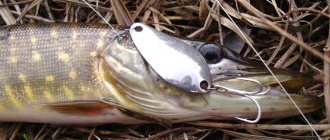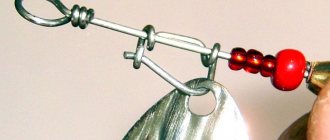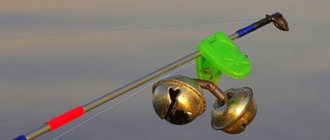What is a zakidushka and features of its use?
One of the fishing methods is to use bottom gear. In fishing circles it is classified as passive. But despite this characteristic, the simplest, unpretentious method, without frills in material resources and painful choices among rods and reels, from time immemorial, the “old-fashioned” method has invariably been considered a throwaway method.
From his entire arsenal, the fisherman had a piece of fishing line, several leashes with hooks, a sinker cast from lead, or a piece of stone or crushed stone of a suitable size, which was found on the shore of a reservoir.
On the shore, the tackle was collected, thrown into the place where the expected prey was caught, and the fisherman could only see the long-awaited bite. The tackle was selected, the fish was removed from the hook and the process was repeated.
The process was simple and gave the fisherman true pleasure - the pleasure of being alone with nature. Blue water, blue sky, green shore, yellow sand underfoot, and not going home empty-handed.
But this is for those who have some practice. But for others, this pleasure begins with the preparatory work.
Pike perch on a bottle donk
A casting option is also used, which can be called the simplest analogue of a spinning reel.
When using this donkey option, the fishing line is not laid in rings before casting to the shore, but is wound on an empty plastic bottle or, even better, on a piece of PVC pipe. Before casting, the tube is directed towards the river, a cast follows and the line is thrown off the tube, as if from the spool of a spinning reel (more on this fishing method). Share with your friends!
Complete set of zakidushki
- Hook. The market has plenty of this product and accordingly one should choose the right one.
There are some numbers written on the packages, which is even more puzzling. But the good thing about the trick is that you don’t have to rack your brains. It is enough to know what a hook is. The main size is the width of the hook. But when choosing it, you also need to take into account the manufacturer. There is a difference between Russian and International classification. It is the width of the hook that determines its number. - Fishing line. What an abundance of hooks in the store, so many fishing lines.
Their difference lies in the manufacturing method and type of material: monofilament and braided cord (braid). For the “old-fashioned” method, a monofilament with a diameter of 0.6 to 0.9 mm for the main line and 0.2-0.6 mm for the leads is sufficient. The main selection parameter depends on the desired result (fish). - Cargo .
For a sinker, either a store-bought product of 100-150 grams, or a piece of brick/crushed stone of a suitable size/volume, which can be found on the shore, is suitable. Pay attention to the shape of the sinker. For fishing in currents, the shape is preferably flat so that the load does not roll along the bottom.
Donk options for catching pike perch from the shore
The simplest bottom for catching pike perch is the rod shown in Figure a. In this case, a rod up to 3 meters long is used, a spinning reel with a spool capacity of 4000 and a fishing line with a diameter of 0.3 mm. A sinker and two stoppers on both sides are threaded through the fishing line, limiting it. No leash is used. Hook No. 8 is tied to the main fishing line.
The following item is used as a signaling device:
In Figure b we see a bottom with a float on the rig, which lifts the bait fish above the bottom so that it does not get entangled in snags and bottom debris. The remaining elements of the equipment are the same as in the first figure.
In image B we see a donkey for fishing at great depths. In this version of the rig, the baitfish walks on a leash, which slides between two stoppers. Live bait can swim in all layers of water. This type of gear increases the chances of catching pike perch. In this case, the bite signal will be the tip of the rod. The main thing is to make sure that the fishing line is in a taut position.
Step-by-step process of making a do-it-yourself snack
The main condition for installation is ease of transportation and storage. For classic tackle (main line, leashes with hooks, purchased sinker), an assembled rig with a reel made of dense foam or cut from plywood and covered with foam rubber, or with a glued piece of foam/cork for attaching hooks, is suitable.
If the use of replaceable leashes is intended, then it is performed on separate reels.
- The hooks are simple.
For ease of installation, the main line is immediately wound sequentially on the reel, and the attached leads should be wound in the opposite direction. - A figure-of-eight loop 10-20 cm long is made from one end of the main line, depending on the size and method of attaching the sinker (using a swivel or carabiner).
- At a distance of 60-80 cm (in the future, this distance is taken as a step between leashes), a 20-40 cm leash is tied, followed by tying the hook.
- The number of leashes can be from 3 to 10, depending on the nature of the reservoir and the adjacent shore. For predatory fish, one is usually enough.
- Figure-eight knot when connecting hooks to fishing line
Tying hooks and leashes is done with a figure-eight knot, depending on the shape of the hook head (eye or blade). In fishing practice, various knots and loops are used. The above are used on bottom gear as the most common of the simple and no less reliable methods of tying knots. - When tightening, it is recommended to wet the knots and loops to avoid thermal jamming of the line.
- The connection of interchangeable leashes is carried out using the “loop-to-loop” technique, having previously made figure-of-eight loops on the main fishing line.
Which live bait to choose
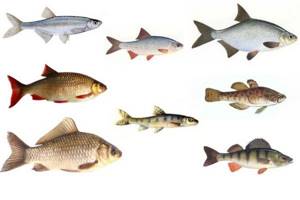
For successful fanged fishing, it is important to choose the right live bait; just any fish, of course, will not work. The fish that will be hooked must be from a local reservoir and be part of the pike perch’s diet. Typically the predator feeds on the following fish:
- perch;
- bull;
- brush;
- minnow;
- roach.
Less common on its menu are:
- silver bream;
- bream.
In the summer at night he hunts for:
- bleak;
- roach;
- perched water;
- small chubs;
- foals.
There is no point in talking about the quality of live bait. And so it is clear that the fish must be fresh, without damage, and mobile. A lethargic fish will quickly fall asleep on the hook, and the pike perch may not pay attention to it at all.
Which bait and lure should you choose?
In fishing, it is customary to distinguish between baits:
- for animals (worm, maggot, bloodworm, i.e. of animal origin);
- to vegetable (bread, grains, various cereals, etc.);
- artificial (flies, spoons, pieces of foam, foam rubber, etc.).
The main baits for casting are worms, maggots, peas, live bait, and pieces of mahogany . These baits do not fly off the hook when casting.
To increase biting activity, experienced fishermen use one feature that they take into account when choosing a hook. The hook is chosen to match the color of the bait: for a worm - a dark hook with a long shank, for maggots - a light hook with a short shank.
Gear design, advantages and disadvantages
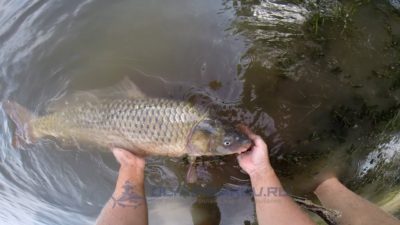
The zakidushka is the simplest bottom tackle for carp fishing. It consists of a fishing line several tens of meters long, at the end of which there are leashes with a hook and sinker.
Benefits of the snack:
- it costs very little , you can make several of these donks to fish with several gears at once;
- the bag takes up minimal space during transportation;
- With a zakidushka, like any donka, it is very convenient to fish far from the shore;
- The bait is well suited for catching carp in the current.
This gear also has significant disadvantages:
- since there is no rod and reel, you have to catch the fish holding the fishing line with your hands - this is quite difficult to do , especially if there is a large and strong trophy on the hook;
- When fishing with a standard bait, at the end of which there is a sinker, and not a feeder, it is difficult to accurately feed the fishing spot and throw the equipment into it over and over again.
Basic techniques and fishing techniques
- A place is selected on the shore that is most suitable for this method of fishing. A smooth sandy or clayey shore, free of any vegetation and irregularities to avoid hooking.
- A pole (peg) 60-70 cm high is installed on the ground, on which the reel is fixed in the lower part. The continuation of the fishing line is fixed at the top of the peg.
- For casting, a flat bank is selected.
At a distance of a step from it, the fishing line is unwound from the reel to the first leash and laid in neat rings on top of each other. This is in order to reduce the useful distance to the sinker. - A section of fishing line with leashes stretches along the border of the coastal strip . The sinker is attached to the fishing line using the throwing method. To do this, the loop is inserted into the hole of the sinker, which is threaded into the loop, followed by tightening.
- A piece of fishing line or twine with a knot at the end is tied to the sinker for easy casting.
- Bait is placed on the hooks , and the tackle is considered ready for use.
- The string (cord) is taken by hand and after some swinging in the lower position to aim for an accurate cast, with a sharp swing the sinker is sent into flight with the subsequent contents at an angle of 45º to the horizon.
- After installing the sinker in a stationary position, the slack is removed from the bottom of the fishing line and fixed at the top of the shaft. Excess fishing line is wound on the reel.
- To signal a bite, you can attach a bell with a previously made figure-of-eight loop at a distance of 0.5 m from the peg.
For lovers of silence, in order to avoid the ringing of bells and not attract curious onlookers with the standard annoying questions “what..., how..., what..., but here I was yesterday...”, instead of a bell, you can hang a piece of a shaft with an end split or install an additional whip in front of a peg with pinching the main line in it.
Fishing process in reverse order:
- the fishing line is neatly rolled into rings at the peg;
- a section of fishing line with leads is laid along the shore;
- the fish, removed from the hook, is sent with a slight movement of the hand into a fish tank or other bag intended for it;
- the bait on the gear is replenished and, if necessary, updated;
- the process is repeated.
Please note: in hot weather, fish should not be stored in a plastic bag with water added from a pond. The shelf life is sharply reduced. It is better to fill the bag with nettles and place it in the shade in a windy place. Or, make a hole in the sand until the humidity is cool, where you can sprinkle your amazing catch.
Fishing tactics

- It is best to fish with rubber bands together and with a boat. One fisherman brings the load on a boat, while the other lowers the gear into the water from the shore. If there is no partner, the process will be a little more difficult and longer. You can do without a boat by throwing the sinker by hand.
- To avoid breaking the elastic, for casting you need to tie a piece of thick fishing line approximately 1 meter long to the sinker on a separate leash. To cast by hand, the fisherman needs certain skill and experience.
- The sinker is brought (or thrown) into the water only once. By stretching, the elastic allows you to fish for pike perch or change bait on the hook without pulling the sinker out of the water. The sinker is removed from the water only at the end of fishing.
- It is best to tie a fishing line on the shore not to a peg, like an ordinary fishing line, but to a flexible bush. You can also use a durable flexible rod, thus providing double shock absorption. At night, it is advisable to hang a bell on a fishing line.
- The pike perch usually quickly swallows the bait, and, sensing the hook, rushes to the side, trying to get rid of it. The hook is usually made sharp and sweeping, although in most cases it is not required.
- The fisherman should not rush - the fish will get tired quite quickly, and the elastic band and flexible bush will not allow him to break the tackle. The tired pike perch is carefully pulled ashore, the gear is put in order and sent back to the fishing spot.
Watch the video of how to throw an elastic band.
Difficult tricks
The evolution of development does not stand still: the fish is becoming more and more careful, and the fisherman is becoming more and more cunning. To achieve the desired result, the fisherman adds to his arsenal all kinds of equipment and the experience of experienced brothers in arms.
Feeder feeder
Every fisherman knows the proverb “it was biting here yesterday, but today it was on the opposite shore.”
To deliver the bait to the “other shore,” they began to use a device made in the form of a shaft , a flat, strong branch, a cut tube from a ski pole 0.8-1.2 m long, equipped at the end with a gentle side branch of 3-5 cm in the form of a knot. The cord from the sinker is attached to this outlet with the possibility of slipping. Using this device as a fishing rod, the tackle can be cast over a distance of 100 m.
To attract fish to the fishing site, the tackle is equipped with a feeder. The feeder is made of a mesh with a middle cell, where complementary food and a sinker are placed. , feeder feeders became widespread . Small spring feeders designed for catching specific fish (crucian carp, crucian carp) have also found use. They can be installed not only on the main line between the leashes, but also directly on the leashes themselves.
When placing bait in the feeder, you should take into account the nature of the reservoir:
- On a reservoir without a current, the state of the bait mixture should be loose so that the mixture creates turbidity when falling.
- During currents , mix with coastal soil 1:1-1:3 to prevent rapid erosion.
The advantages of this gear are obvious over others: simplicity of design with minimal costs.
Among the disadvantages : only one - with each bite the tackle requires re-casting.
This drawback is devoid of another tackle - an elastic band.
The usual bait for pike perch
You can catch pike perch using a regular bait without a rod. This method showed especially well in narrow rivers and small channels, where there is no need to make long casts, up to 20 meters. The tackle consists of an ordinary wooden reel on which a fishing line with a diameter of 0.4 mm is wound. A weight weighing 150-200 grams is attached to the end of the fishing line. Just above the sinker we tie a leash made of fluorocarbon or titanium 30-40 cm long. We tie a hook or tee No. 8 to the leash.
It is better to use a pear-shaped or spherical sinker, so they fly better and more accurately. You need to throw very carefully, making a small swing. It is better to use a side cast, in which the live bait will reach undamaged. As a signaling device, you can use a guard or the same one as in the figure above for the donkey.
Zakidushka with rubber shock absorber
This tackle belongs to the type of bait, but it occupies a separate level in the bottom class, as it has some features both in design and in the technique of its use.

Donka with rubber shock absorber (elastic band)
History is silent about its origin. From the stories of the oldest fishermen it is not clear: either it came from the north, or from the Far East, or from local fishermen.
One thing is known for certain: until recently, this gear was considered poaching . Therefore, in order to use it, you need to consult the Fishing Rules of the relevant region (fishing location, number of hooks) about the possibility of use in a given area.
In the Central regions of Russia, the “elastic band” (the name of the tackle in common people) received its main significance when fishing for saberfish, and in the Southern regions - when fishing for roach. A true connoisseur of nature will remember the seething stream of silver water, but for someone of the opposite nature, you won’t be able to see the span of his arms with your gaze.
Based on this, the zakidushka has undergone some elements of design differences.
Device and basic techniques
The very name of this snack speaks about the main element of the design - the elastic band.
In Soviet times, including the era of “shortages in stores and no shortage among the population,” prefabricated models for the creative development of the school-age category were especially popular among fishermen. This category was saved by the growing progressive development of the automobile industry and the production of consumer goods (bicycles). Rubber bands were cut from tire inner tubes with a sharply sharpened object (similar to a stationery knife).
The requirements for the elastic band were stricter than those of the “Quality Mark”:
- elongation - no less than 1:3;
- surface - 100% smooth without scoring, undercuts, burrs;
- diameter difference - no more than 2%;
- reliability - at least 3 exits to the reservoir.
Currently, there is no limit to the abundance of hooks, lines, and elastic bands.
The elastic is installed between the main line and the sinker. The length of the elastic is determined by calculating the casting distance of the tackle, taking into account the strength of the current and its extensibility.
Requirement for the sinker . The sinker must have a mass (weight) that prevents the force of moving from its place, equal in total to the tensile force of the elastic band and the force of the current.
Presumably, calculating the length of the rubber and the main line comes down to determining the distance when casting by hand equal to 40 m.
Approximate parameters of the cast (without taking into account the current):
- elastic band - 7 m (1:3);
- main line - 25 m + 2-5 m on the reel.
Leashes - 0.16...0.25 mm, shortened 15-25 cm. Attachment point to the main fishing line. The leashes are installed between beads of different contrasting colors (red, blue, green, yellow, white). The distance between the beads is 40-60 mm. The beads are secured with a locking knot.
In addition to equipping the tackle, the fisherman’s arsenal is supplemented by two fishing lines:
- One of them (understudy) – the length corresponds to the length of the main fishing line.
- The second (additional) is the length of the main line + the length of the rubber shock absorber.
On the shore, instead of the main fishing line, a backup line is laid out. An elastic band is attached to the doubler using a swivel with a carabiner and a sinker behind it. An additional fishing line is attached to the sinker, the opposite end of which is fixed on the shore at a distance from the shaft, which ensures normal operation with the main fishing line without interference.
This apparent complexity is typical for ensuring the safety of the main gear when casting and pulling out the sinker to ensure the integrity of the elastic. The tackle is thrown to the fishing point. The backup line is reeled onto a spare reel. The main fishing line is attached to the elastic band, which is subsequently fixed to the peg.
To prevent injury from hooks as a result of the reverse reaction of the rubber band, the shaft with the attached reel is moved deep into the shore at a distance of 6-8 m, if possible, or an additional peg is placed along the shoreline. The main line attachment point with an elastic band is fixed on the front peg, which ensures safe attachment of the bait. This point should be taken into account when calculating the parameters of the gear.
After all the preparatory work, the equipped tackle is smoothly released into the water.
Since sabrefish and other predatory fish prefer moving bait, you should periodically hook with a smooth, quick, sweeping movement of the hand (so as not to deprive the fish of its teeth). After hooking, the tackle is smoothly released. The pause between hooks is selected depending on the activity of the fish.
After enjoying the day, the main line is first selected and unfastened, then the additional sinker and elastic are selected.
Additional features
The fish swims along the bottom (as people say), but at times it breaks away from the bottom and rises to the upper layers of the water . This is preceded by various factors:
- fish movement during the pre-spawning period;
- change in climatic conditions (sharp increase in temperature, change in atmospheric pressure, etc.);
- mayfly emergence;
- and who knows what she wants.
In such cases, at the junction of the main fishing line and the elastic band, a twine (cord) is tied with a piece of foam plastic or an empty plastic bottle such as Pepsi-Cola, which acts as a float. This will allow you to lift the tackle from the bottom and try to find the long-awaited prey in the upper layers.
To obtain the desired result, various fishing rods and spinning rods have been widely used in this type of fishing, which has made it possible to use the tackle for longer and more accurate casts, improve the conditions of the process, and also increase its sensitivity by reducing the diameters of the fishing line.
Such gear is called donka, but that’s another story.
Fishing with hooks
Fishing with hooks, despite the simplicity of this gear, is by no means simple and varies greatly depending on where it is carried out and what kind of fish is its object. Moreover, some types of fish require some changes in equipment. This is all worth considering in detail.
Fishing in still waters
As a rule, it is carried out on ponds and lakes, as well as in oxbow lakes and river branches. Main fishing objects: large roach, bream, crucian carp, carp, tench, large perch, pike perch, pike.
Fishing with hooks in still waters is often carried out where there are quite extensive thickets of underwater vegetation. In order for the equipment to catch less algae, a round or pear-shaped sinker is used.
Bream
When catching bream using hooks, use the standard version of the tackle. A worm or bloodworm, collected in a bundle with a nipple ring, is used as a nozzle.
Casting is carried out to deep places, best of all - to the dump of a flooded riverbed. Fishing time is morning and evening, and it makes sense to leave the gear at night.
Often, catching bream with hooks is carried out in places where the bottom is solid silt, in which the sinker with bait often sinks. In order to avoid this misunderstanding, the leash of the tackle is equipped with a floating element, which is half an ordinary wine cork, as well as a small pellet that will prevent the bait from floating up too high.
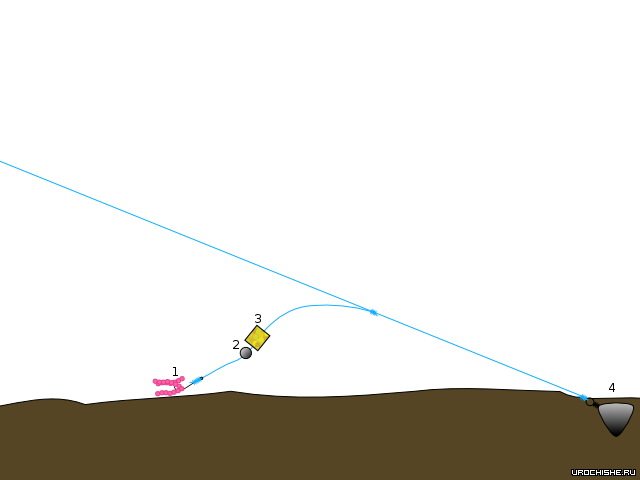
Rice. 5. Hook for muddy bottom: 1 - hook with nozzle; 2 - pellet; 3 - piece of cork; 4 - sinker, sank in the silt.
A small nuance: the weight of the pellet and the size of the piece of cork are selected in such a way that, together with the hook, the entire structure sinks as slowly as possible.
To secure the cork to the fishing line, no special tricks are required. To do this, a cut is made in it with a knife along its entire length to approximately the middle of its thickness. The fishing line is threaded into the slot and, having bent through the cork in one turn, is threaded again - so that there is an overlap of the turn in the slot. Now the cork holds firmly enough on the fishing line and does not fly off if it is pulled.
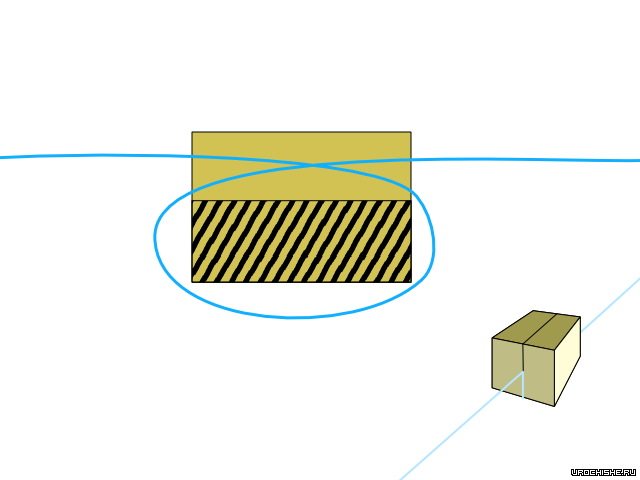
Rice. 6. How to attach a cork to a fishing line for a cast with an “unsinkable” rig.
Carp
Carp is caught better than all other pond fish using bait. Both standard equipment and special carp equipment, that is, hair equipment, are suitable for it. You can use anything as a bait - from corn with undercooked potatoes to boilies.
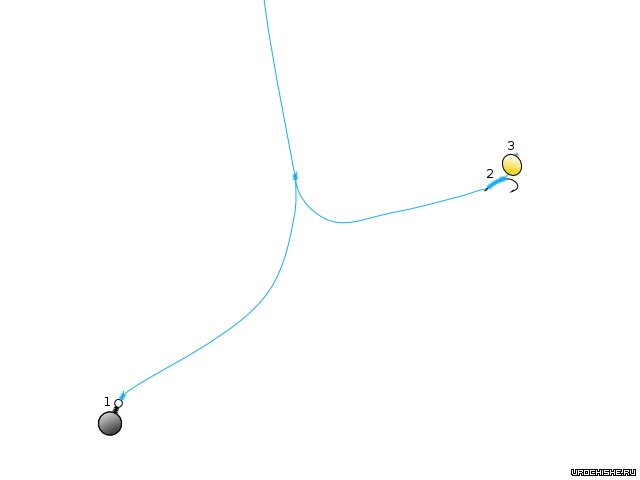
Rice. 7. Casting for carp with a hair rig: 1 - round sinker; 2 - a hook tied with a knot with an increased number of turns - for fixing a hair loop on the forearm; 3 - potato.
Pike
In the case of pike, the zakidushka is a natural bottom vent. Such gear is thrown into places where the toothy predator is most active: near snags and thickets of underwater vegetation. The tackle performs especially well in the spring - in muddy water.
For pike fishing, the hook is equipped with a tungsten leash and two treble hooks, one of which is attached to the end of the leash, the other a little higher. It is also possible to fish with a rig with one hook, which will be discussed below in the section on river fishing (casting for burbot).
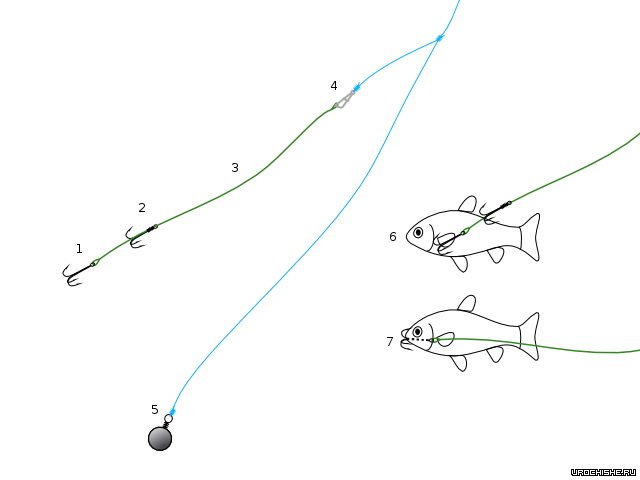
Rice. 8. Casting for pike: 1,2 - tee hooks; 3 — tungsten leash; 4 — fastener; 5 - round sinker; 6 - method of placing live bait on a leash with two hooks; 6 - a method of placing live bait on a leash with one hook.
Regarding how to attach live bait. If the leash is equipped with a leash with two hooks - the first of them clings under the pectoral fin, the second - behind the back. If the leash is single-hook, it is quite possible to unfasten it and pull the bait through the mouth, leading it out through the gill slit, and then fasten it to the equipment. In the second case, the live bait will last longer.
Zander
The situation with pike perch is somewhat more complicated than with pike, because in reservoirs it prefers greater depths, usually located far from the shore. However, if it is possible to throw a stash into its habitat, success will be guaranteed.
Pike rigs are used to catch pike perch.
Fishing on rivers
The main objects of river fishing with hooks are the same large roach, bream, ide, chub, asp, pike, perch, burbot, catfish, and sturgeon. You can fish at any time of the year, but in the spring - in muddy water - baitfish reveal their maximum potential, especially for such predatory fish, which during this period are almost not caught with other gear.
When river fishing with hooks, one nuance related to the current should be taken into account. The fact that it is not a hindrance for this tackle (especially when using a good, heavy sinker) is a fact. However, we should not forget that at times the river carries all sorts of garbage such as grass, algae and other elodea. So, if the bait is abandoned, as they say, “in the stream,” and is not checked and cleaned for a long time, in the end the fisherman will not pull out a fish, but a hefty garland of that same garbage. Which, hanging on a fishing line, increases its windage, and therefore, sooner or later the current pulls it and carries it away.
That is why, when river fishing with baits, fishermen try to throw them in places where the current is quieter, but at the same time the main stream is located nearby.
By the way, a special flat-shaped sinker has even been developed for the river version of the tackle. It lies flat on the bottom and does not float in the current, and when pulled out, it does not twist the rig. Such a sinker can be easily cast at home on a gas stove in an ordinary aluminum spoon.
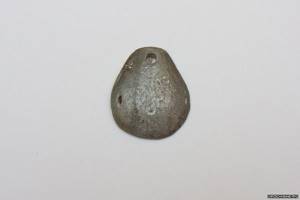
Photo 3. Homemade sinker for river fishing.
Chub
Catching chub with bait is usually carried out during those periods when this fish feeds in the bottom areas of the water. This is almost the entire spring, the very beginning of summer, its end, and also autumn until freeze-up. A frog or gudgeon is used as a bait. Worms and other baits (for example corn) also work, but somewhat worse.
The time for catching chub with bait is twilight and night. It is especially successful in the morning. However, it makes sense to leave the tackle abandoned during the day, especially in cloudy weather, when the chub can bite all day long.
Throwing gear is best done in places with a quiet or no current. As a rule, this is a coastal zone or river reaches. The main thing is that there is a roll or tug nearby. The chub, as you know, stays behind or in front of such places. In the spring, fishing depth is not particularly important, but the closer it gets to freeze-up, the better the pits begin to “work.”
If a small frog is used as a bait, standard equipment will do (see Fig. 1 - “Correct bait”). For a gudgeon, it is necessary to equip the side leash with some kind of tackle with two, or even better, three hooks. The same equipment is suitable for a medium-sized frog.
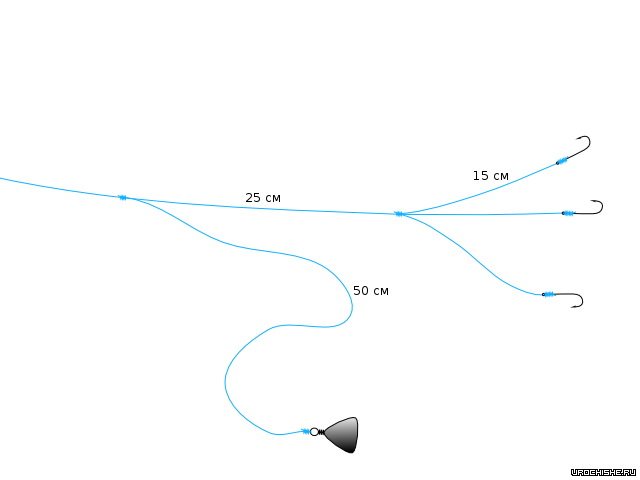
Rice. 9. Casting for chub - equipment for live bait.
How to bait a minnow and a frog? In the first case, we hook the live bait by the upper lip, back and tail. In the second case - behind the back and on each thigh.
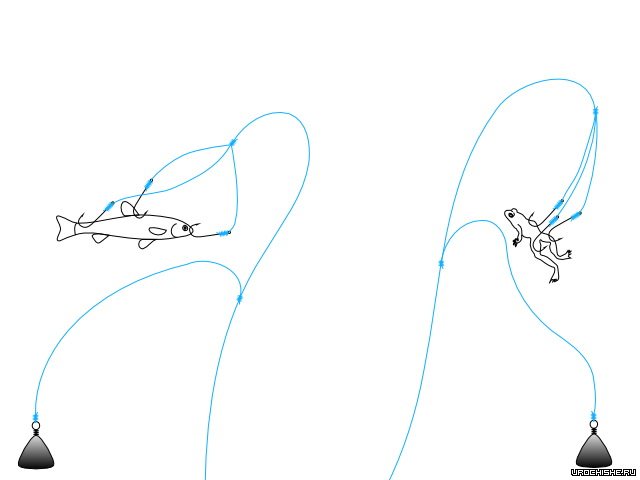
Rice. 10. On the left is a chub bait with bait bait, on the right is it with a frog attached.
Why are three hooks used? This is due to the peculiarity of the chub’s bite. It can swallow live bait from both the head and tail. The frog may be snatched from the snout, or may even begin to be eaten from the back paw. That’s why, from the zakidushki, where there are two hooks instead of three, there are occasional gatherings. Never with a three-hook rig.
Regarding how to connect this three-lead structure. Everything here is extremely simple: one of the leashes is the main fishing line, and the other two are the most ordinary side leash, but double - that is, from a fishing line folded in half.
Sometimes in a place where chub is caught using bait, there is some probability of catching a pike. It would seem that in this case it is better to use a tungsten leash. However, practice shows that this is not necessary. Firstly, chub fishing is carried out at a time when pike are usually inactive. Secondly, a triple leash made from a very thick fishing line is usually quite enough to successfully remove (once) a toothy predator. The main thing here is not to miss its bite and not to hesitate when fishing.
I know of quite a decent number of cases when, while fishing for chub, a pike was caught on hooks. But there was never a time when she cut off the leashes with her teeth. Every time a fisherman (including your humble servant) pulled a pike ashore.
Asp
In the summer, biting an asp on a bait is most likely an exception to the rule. However, in the spring - in muddy water - this fish periodically catches live bait, which can be a gudgeon, a small minnow or a bleak. After spawning, the asp may well peck at a dung worm or crawler.
If you want to purposefully catch an asp in the spring by casting, know that at this time the fish tries to stay closer to the shores - where the current is not as strong as on the main stream. This is where you should throw the bait.
Burbot
Any kind of bait for burbot is not suitable - it requires special equipment. Firstly, a fairly long tungsten leash is required, and secondly, the ability to quickly replace it is necessary. As you know, the burbot’s teeth resemble a grater, and it swallows the bait quite deeply. Therefore, if it is caught, it is much easier to unhook the swallowed leash and quickly hook up a new one instead, than to deal with removing the swallowed leash from the belly of the fish.
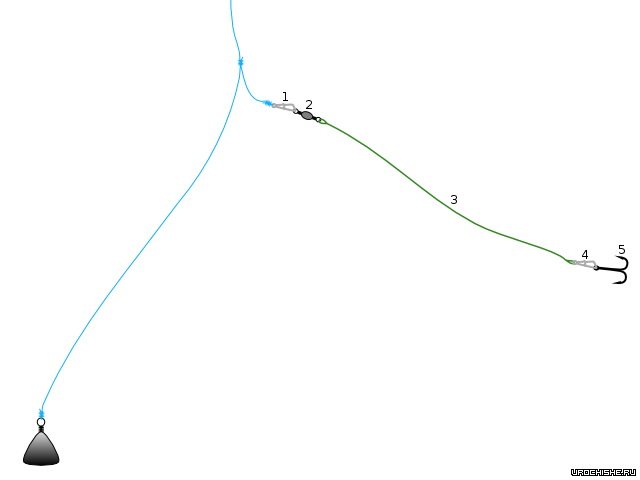
Rice. 11. Throwback for burbot - equipment with the ability to quickly replace the leash (and hook - if necessary): 1 - clasp; 2 — swivel; 3 — tungsten leash; 4 — fastener; 5 - double hook.
Suitable baits for catching burbot: a bunch of dung worms or crawlers, but the best ones have proven themselves: crucian carp, gudgeon, ruff (large burbot especially loves it), or a piece of some fish (for example, crucian carp or carp bought in a store) . Besides everything else, nothing prevents the fisherman from chopping the same gudgeon or ruff. By the way, if you are supposed to fish with a piece of fish, a single hook is quite enough.
They catch burbot in quiet places of the river. Ural fishermen strongly recommend doing this from a steep, washed-out shore. According to them, here catching burbot with hooks is always the most successful.
The time of year when burbot bite well on bait is spring (especially immediately after the rivers open), or autumn before freeze-up. The colder the weather, the better the bite will be. Well, it goes without saying that you should put up the covers only at night.
Sterlet
And now, gentlemen, readers, it’s time to talk about catching fish like sterlet, which lives in many Siberian rivers and lived (and according to some information, still lives) in some rivers of the Urals. By the way, its fishing is prohibited in the Urals, but in Siberia it can be caught under a license.
Since ancient times, Siberians have been fishing with hooks, and in this way they catch not only sturgeon, but also other types of fish. As for sterlet fishing, it is usually carried out in pits and in the adjacent water area. However, this fish does not always stay at depth. Sometimes the sterlet goes out to the main current, and sometimes it wanders in shallow water. Moreover, it is completely unknown at what time of day where she will be. Therefore, the best tactical technique when catching it with hooks is to fish both the hole itself and the exit from it, as well as the shallow places bordering it.
Siberians consider a worm to be the best bait for catching sterlet. Moreover, it doesn’t matter which one - crawling, or red dung. The sterlet takes both the first and the second for sure.
It does not require any special tricks in the equipment - “standard” tackle will do, although some experts in catching sterlet with casts recommend using a hook with a long shank. This one, according to Siberian fishermen, is easier to pull out of the peculiar mouth of this fish.
Coil
For catching pike on a donkey, a spinning or carp reel with a spool of 3000 and above is suitable. The larger the size of the spool, the faster the line is reeled out and when fishing at long distances, reels with spools of 4000 and above are used.
When fishing coastal areas with bottoms, they use reels with 3000 and even 2500 spools, the main thing is that they are equipped with reliable and functional friction brakes with fine tuning. When fishing for pike with a bottom, the angler does not need to hold the rod in his hands all the time, as is the case with spinning anglers, so the weight of the reel does not play a big role.
It is desirable that the reel be protected from moisture and sand getting into the middle and be equipped with 3 or more bearings.
Fishing tips
In order to return from Sazanya Bay with a decent catch, you should approach this process competently. First, carefully study the topography of the reservoir to understand where the bite will be and where it will not.
Use my fishing tips:
- display up to 20 designs at once;
- install zakidushki at a distance of up to 1.5 meters from the shore;
- experiment with baits, try fishing with different baits.
- Important! For casting, you should use only live bait or pieces of fish.
If you use live bait, then fishing will be 100% active. Pieces of fish can be used, but this option is only suitable for people who prefer a passive form of fishing.
